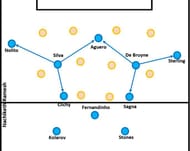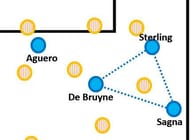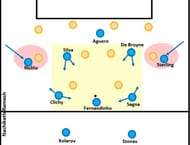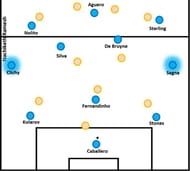Silva and De Bruyne in attacking midfield – Key to ball progression
What was very interesting about Guardiola’s line-up yesterday was his preparedness to face a low block defense from Sunderland. Although Sunderland didn’t exactly sit very deep, they had a tight shape in front of the box.
With Silva and De Bruyne starting as #10s, Guardiola was able to move them a little bit wide and occupy the half-spaces. This was providing an excellent connection between Silva / De Bruyne and the players around them. If Sunderland decided to press the players in the half-space, then they were at the risk of opening space somewhere else.
Most of the time, due to good structure in possession, Silva and De Bruyne had at least one safe passing option.
Also, half-space to half-space ball switches were possible and gaps in the defensive block was being created as a result of this.

Triangles to beat pressing on the wings
Since a player with the ball on the wings will be restricted to only 180 degrees to move, it is relatively easy to setup pressing traps and execute them in the wings. Sunderland, too, had plans to press, win the ball back and counter-attack through the wings.
But since Manchester City players close to the winger were forming triangles, it became tough for Sunderland to press. Thus with good passing structures, City collectively achieved pressing resistance.
In general, City had the aim of getting players behind the line of pressure. We saw that City played with seven lines and it was very easy for them to beat pressing with such a staggered structure.
City’s shape in possession good enough to prevent Sunderland’s counter attacks
City started with a 4-1-4-1 formation. In the build-up phase, it was changing to 3-2-2-3-ish shape. After the build-up phase, when the ball was in the middle third City was changing to a 2-3-2-3 shape with Fernandinho moving into the space between Clichy and Sagna. This had two advantages from City’s perspective.
- Manchester City had five players in the center and half-spaces in the middle third against Sunderland’s four. This overload enabled City to dominate the possession, which we saw that City had 77% of the ball possession against Sunderland, and circulate well in order to patiently create openings. Also, note how well prepared City is to prevent counter attacks through the center.
- City had four players one the left side of the field and four the right. Three were in the middle. The four on the sides were always joined by Fernandinho whenever the ball was lost. So City was able to overload the zone where the ball was lost and try to regain possession quickly in the wide regions.
City build-up game
One of the main things expected from Guardiola’s side was the attack initiation through Salida Lavolpiana method – in which the ball is brought out from the back with the goalkeeper as the initial point and numerical superiority is achieved.
City’s center backs were split by Fernandinho to make a chain of three in front of Caballero.
This provided a 3v2 or 4v2 including the goalkeeper in favor of City. With smooth ball progression from the defensive third, City was able to carry out the numerical advantage over to other zones at micro (1v0 or 2v1) and sometimes at macro level (5v4).
Fernandinho, dropping deep, was forming a rhombus with one of the inverted full back. This was forcing Sunderland to press high with large numbers, which was only allowing City some breathing space higher-up the pitch.



